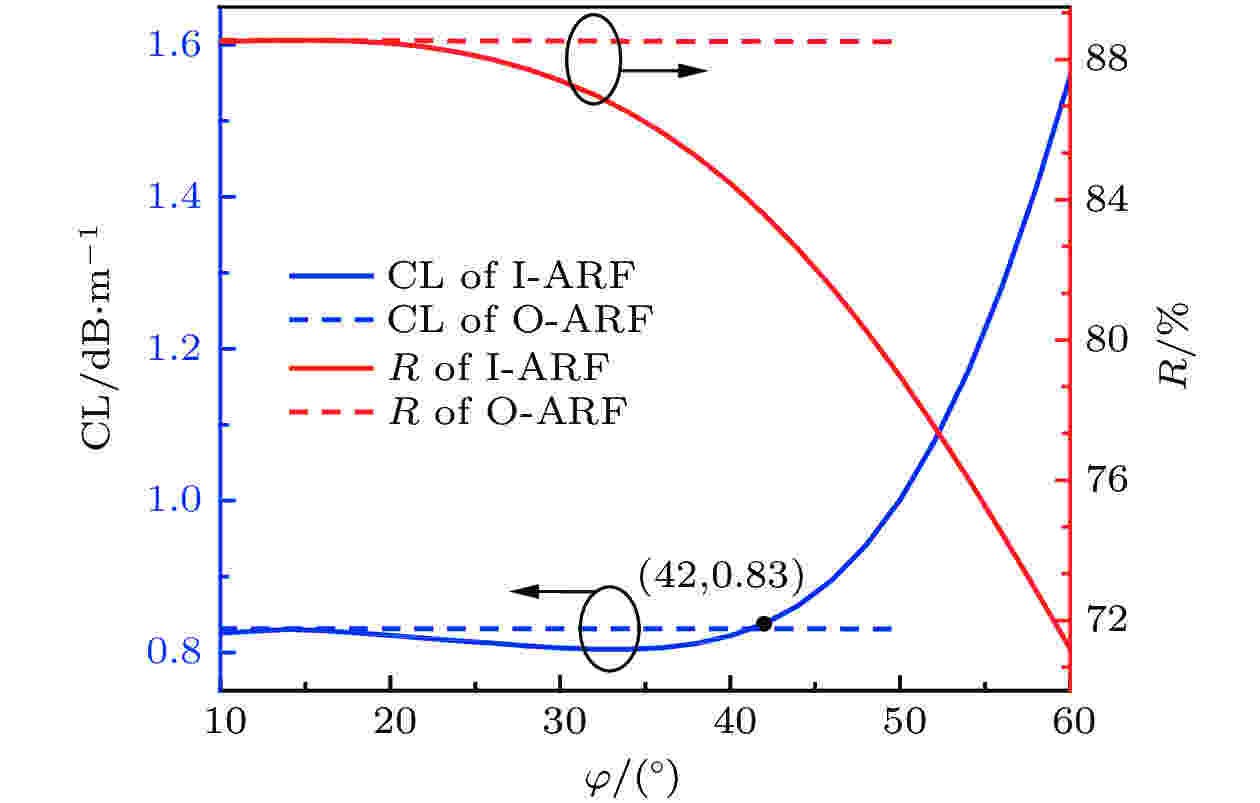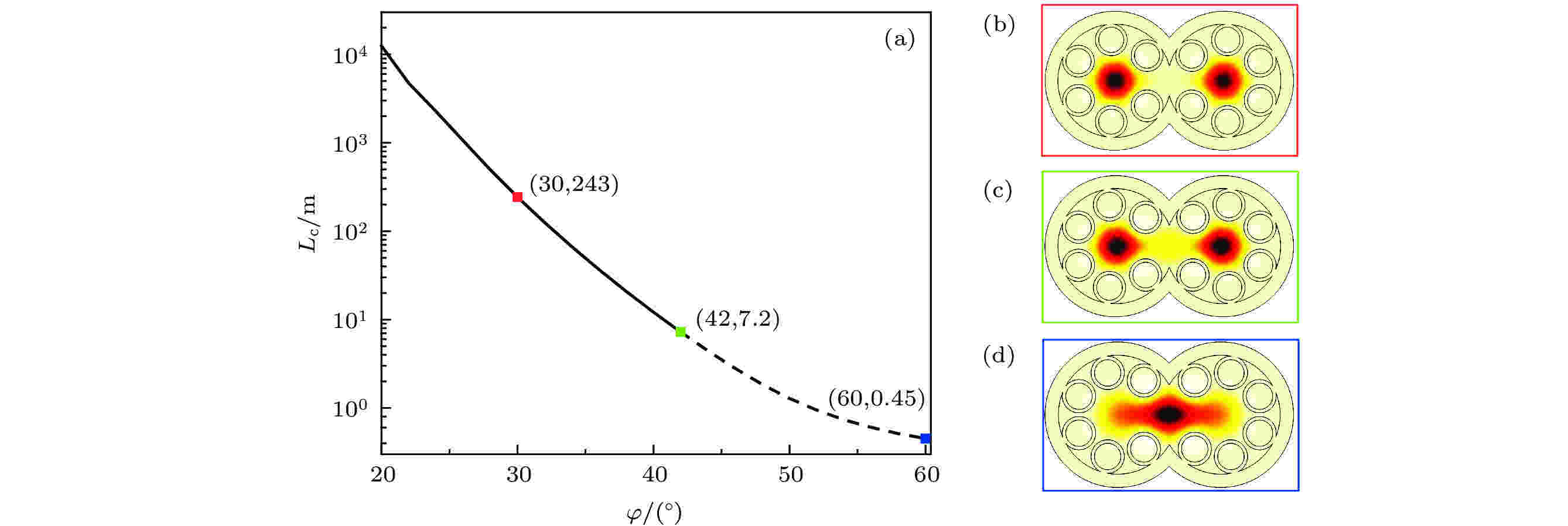全文HTML
--> --> -->发展THz技术不仅需要高性能的THz波导技术以实现THz波的高效传输, 同时也需要适用于THz波段的光开关、调制器和耦合器等重要的光学器件. 随着对THz波导技术的深入研究, 研究人员提出了许多高性能THz波导结构, 如金属空芯管波导[5]、平行金属板波导[6]、光子晶体光纤[7]以及微结构空芯光纤等, 其中空芯光子晶体光纤和空芯反谐振光纤(hollow-core anti-resonant fiber, HC-ARF)近年来得到了迅速发展[8-10], 为基于光纤结构的THz光学器件的研究提供了有力的技术手段. 迄今为止, THz单模单偏振光纤[11,12]和高双折射光纤[13-15]已得到了较为广泛的研究, 但是对实现THz波定向耦合的光纤结构和器件的研究还比较少见. 2009年Dupuis等[16]通过把两个亚波长聚合物光纤临近放置, 利用光纤包层中能量相互作用实现定向耦合. 对于这种耦合结构, 纤芯模式与吸收介质的重叠面积较小, 材料吸收损耗较低, 但是亚波长聚合物光纤以空气作为包层, 容易受到外界的干扰而产生较大的散射损耗, 特别是空气中水蒸气的影响. 为了克服这一缺点, 2013年姜子伟等[17]提出了一种基于空芯光子晶体光纤的THz光纤定向耦合器, 光纤的包层由亚波长尺度呈三角晶格排列的空气孔组成, 两个纤芯分别由4个空气孔构成类菱形结构, 该结构成功将能量耦合过程引入光纤结构内部, 较好地降低了耦合器的传输损耗, 在1.8 THz以下取得了较好的定向耦合结果, 但是这种THz光纤定向耦合器结构相对复杂, 不易加工, 且无法在2 THz以上实现定向耦合.
为了探索结构简单且能在更高的传输频率下实现定向耦合光纤结构, 本文研究了HC-ARF的内、外包层的排列分布对传输特性的影响, 并设计了两种不同的双芯反谐振光纤结构. 利用有限元分析软件COMSOL对光纤的损耗特性、耦合特性等进行了理论分析, 结果表明, 在一定范围内改变HC-ARF内、外包层的排列分布, 可实现在保持光纤传输特性的同时, 改变纤芯模场分布, 从而可以利用模式泄漏耦合机制在太赫兹波段实现双芯反谐振光纤的定向耦合, 本文通过改变纤芯距离和纤芯间的间隙大小在2.5 THz的传输频率下实现了耦合长度为0.72 m的定向耦合.
2.1.结构设计
本文采用的HC-ARF基础结构如图1(a)所示, 纤芯直径Dcore为2 mm, 6个内包层管的直径d为1 mm, 管壁厚t为0.13 mm, 满足反谐振周期条件


 图 1 端面示意图 (a) HC-ARF基础结构; (b) O-ARF; (c) I-ARF
图 1 端面示意图 (a) HC-ARF基础结构; (b) O-ARF; (c) I-ARFFigure1. The cross-section of (a) HC-ARF, (b) O-ARF, and (c) I-ARF.
光纤材料选用环烯烃共聚物(cyclic olefin copolymer, COC), 相比于聚乳酸、有机玻璃等材料, 这种材料的折射率在2.5 THz及更高的频率下能够稳定在1.53左右, 其材料色散低至可以忽略, 并且这种材料具有较低的吸收系数[18,19], 因此该材料是较为理想的THz光纤基材.
2
2.2.模拟结果分析
光纤的限制损耗(confinement loss, CL)是影响 其传输特性的重要因素, HC-ARF中限制损耗[20]为
在2.5 THz的传输频率下, 改变内、外包层对O-ARF和I-ARF的限制损耗以及纤芯能量占比的影响如图2所示, 不同间隙大小的O-ARF和I-ARF的模场如图3、图4所示. 由图2中的蓝虚线和红虚线可知, 在O-ARF中, 随着间隙的增大, 限制损耗和纤芯能量占比没有明显的变化, 分别稳定在0.83dB/m和89%左右, 由图3所示的O-ARF的模场分布图可见, 外包层的缝隙对纤芯模场没有明显的影响; 由图2中的蓝实线和红实线可知, 在I-ARF中, 随着间隙在一定范围内增大, 限制损耗略微减小后缓慢增大, 在φ = 42°时达到0.83dB/m, 同时纤芯能量占比从89%略微减小到83%; 随着间隙进一步增大, I-ARF的限制损耗显著增大、纤芯能量占比显著减小, 在φ = 60°时限制损耗显著增到1.58dB/m、纤芯能量占比减到71%. 由图4所示, 随着内包层圆间隙的增大, I-ARF的纤芯模场向间隙略微偏移, 但是间隙进一步增大后, I-ARF的纤芯模场出现了明显的偏移. 对比可知, HC-ARF主要利用内包层管将光限制在纤芯内传输, 剥离部分外包层不会对HC-ARF的传输特性和模场分布产生影响, 并且HC-ARF在不影响传输特性的情况下允许内包层管存在一定大小的间隙, 使部分纤芯能量随间隙泄漏, 但间隙过大会破坏HC-ARF的基本结构, 纤芯内大量的能量将从间隙泄漏, 模场分布发生严重偏移, 光纤传输损耗急剧增大. 由此可见, 在不影响HC-ARF传输特性的情况下, 可以剥离部分外包层、扩大某一处内包层管间隙以实现模式泄漏, 符合双芯反谐振光纤的模式泄漏耦合机制, 为接下来设计THz双芯反谐振光纤并实现定向耦合提供了可能.
 图 2 I-ARF与O-ARF的限制损耗和纤芯能量占比随φ的变化曲线
图 2 I-ARF与O-ARF的限制损耗和纤芯能量占比随φ的变化曲线Figure2. Confinement loss and energy rate as a function of φ for the fundamental mode in I-ARF and O-ARF.
 图 3 模场图 (a) HC-ARF; (b) φ = 30°, O-ARF; (c) φ = 50°, O-ARF
图 3 模场图 (a) HC-ARF; (b) φ = 30°, O-ARF; (c) φ = 50°, O-ARFFigure3. Fundamental mode distribution of (a) HC-ARF, and O-ARF of φ = 30°(b) and φ = 50° (c).
 图 4 模场图 (a) HC-ARF; (b) φ = 40°, I-ARF; (c) φ = 60°, I-ARF
图 4 模场图 (a) HC-ARF; (b) φ = 40°, I-ARF; (c) φ = 60°, I-ARFFigure4. Fundamental mode distribution of (a) HC-ARF, and I-ARF of φ = 40°(b) and φ = 60° (c).
3.1.双芯耦合理论
对于HC-ARF而言, 利用反谐振效应将传输的光限制在纤芯内, 其纤芯模式与包层模式几乎没有重叠, 故并不能像普通石英光纤一样单纯靠拉近距离实现定向耦合, 只有改变其内部结构, 组合成双芯结构或多芯结构, 在保证原有空芯光纤波导功能的同时, 将各自的模式泄漏到相邻的纤芯中, 使纤芯模式相互影响从而实现定向耦合, 这种耦合机制也被称为模式泄漏耦合机制. 用于分析光纤耦合原理的耦合模理论同样适用于该耦合机制, 耦合模理论的核心是耦合模方程. 下面从耦合方程出发, 对双芯反谐振光纤的耦合原理进行分析.在多芯结构中由于发生定向耦合, 电场强度分布将会发生改变, 表示为各纤芯电场强度分布的叠加[21], 即

双芯反谐振光纤利用双芯连通的间隙进行模式泄漏以实现定向耦合, 双芯之间的模场重叠很小, 两个纤芯之间的场强系数满足耦合模方程:
两个纤芯所传输模式的功率各为



由(7)式可知, 当


这说明, 利用双芯反谐振光纤在传播过程中的对称模s和反对称模a的传播常数就可以分析得到该光纤的耦合长度. 为了便于研究, 本文利用耦合长度来反映双芯反谐振光纤的耦合特性, 即双芯反谐振光纤的耦合长度越短, 耦合性能越好.
2
3.2.结构设计及模拟结果分析
为了在HC-ARF中实现定向耦合, 本文设计了一种较为直接的解决方案, 即将两根相同的HC-ARF剥离部分外包层、扩大并调整某一处内包层管间隙后进行镜像组合, 形成如图5(a)所示的双芯结构, 称为镜像双芯反谐振光纤. 图5(b), (c)分别为该光纤在x偏振方向上对称模s和反对称模a的模场图, 前者的两个纤芯模场都处于正强度峰中, 后者的一个纤芯模场处于正强度峰中, 而另一个处于负强度峰中. 图 5 (a) 镜像双芯反谐振光纤端面示意图; x偏振方向上的对称模s (b)和反对称模a (c)的模场图
图 5 (a) 镜像双芯反谐振光纤端面示意图; x偏振方向上的对称模s (b)和反对称模a (c)的模场图Figure5. (a) The cross-section of dual-core HC-ARF with mirror composition; the fundamental mode distribution of even-mode s (b) and odd-mode a (c) at x-polarization.
在镜像双芯反谐振光纤中, 影响耦合长度的主要因素是间隙大小φ. 镜像双芯反谐振光纤在x偏振方向上的耦合长度随φ的变化如图6(a)所示, 图6(b), (c), (d)分别表示φ为30°, 42°和60°时光纤对称模s的模场图. 可以发现, 随着间隙φ的增大, 耦合长度呈指数下降, 并在φ为42°时实现耦合长度为7.2 m的定向耦合. 由图6(b), (c), (d)所示的场强分布的变化表明, 当φ ≤ 42°时对称模s在两个纤芯中保持独立; 但当φ > 42°时, 对称模s的本征模式在结构中心出现了明显的独立模式, 两个纤芯的模式向结构中心偏移而发生重叠.
 图 6 (a) 镜像双芯反谐振光纤的耦合长度随φ的变化曲线; 光纤在x偏振方向上的对称模s的模场图 (b) φ = 30°; (c) φ = 42°; (d) φ = 60°
图 6 (a) 镜像双芯反谐振光纤的耦合长度随φ的变化曲线; 光纤在x偏振方向上的对称模s的模场图 (b) φ = 30°; (c) φ = 42°; (d) φ = 60°Figure6. (a) Coupling length as a function of φ for dual-core HC-ARF with mirror composition and the fundamental mode distribution of even-mode at x-polarization when (b) φ = 40°, (c) φ = 42° and (d) φ = 60°.
图6说明间隙过大会破坏了两侧HC-ARF的波导作用, 使得双芯结构中心区域出现了类HC-ARF结构, 不再符合耦合模理论, 再扩大间隙大小也无法实现定向耦合, 这与第2节中HC-ARF关于间隙大小φ的分析一致. 因此这种光纤受间隙大小的限制无法得到理想的耦合长度. 为了解除镜像双芯反谐振光纤受间隙大小的限制并进一步缩短耦合长度, 在双芯结构镜像组合的基础上, 改变结构内部包层管排列分布, 调整纤芯距离形成如图7(a)所示的新型双芯结构, 称为包层重构型双芯反谐振光纤. 该结构将包层管1和2移动到双芯连接区域, 二者的距离为dr, 两个纤芯的距离为Dr, 每一侧的5个包层管在光纤内均匀分布. 在不改变整体结构内部包层管数量的情况下, 利用包层管1和2将两芯区域隔开, 这不仅确保了左右两部分符合HC-ARF结构, 而且能够利用包层管1和2之间的间隙进行模式泄漏以实现定向耦合.
 图 7 (a) 包层重构型双芯反谐振光纤端面示意图; x偏振方向上的模场图 (b) 对称模s, (c) 反对称模a
图 7 (a) 包层重构型双芯反谐振光纤端面示意图; x偏振方向上的模场图 (b) 对称模s, (c) 反对称模aFigure7. (a) The cross-section of dual-core HC-ARF with cladding reconstruction; the fundamental mode distribution of (b) even-mode s and (c) odd-mode a at x-polarization.
在该光纤中, 影响耦合长度的主要因素不仅是间隙大小φ, 也包括包层管1和2之间的距离dr与两个纤芯的距离Dr. 不同Dr下的耦合长度随dr的变化曲线如图8(a)所示. 可以发现, 随着dr从0.9 mm增加到1.4 mm, 不同Dr下的耦合长度均呈指数下降, 由此可见dr可以显著影响耦合长度, 而在相同的dr下, Dr从2.6 mm到3.6 mm的变化则对耦合长度的影响很小. 不同Dr下的纤芯能量占比随dr的变化曲线如图8(b)所示, 可见两者呈反比, 且Dr越小, 纤芯能量占比随dr的变化程度越小. 根据第2节所得结论, 为保证I-ARF光纤功能的完整性, 需要使纤芯能量占比在83%以上, 此时光纤在Dr = 2.6 mm、dr = 1.2 mm时具有最佳定向耦合效果, 耦合长度为0.72 m, 纤芯能量占比为83%, 对应的在x偏振方向上的对称模s和反对称模a的模场图如图7(b), (c)所示. 由此可见, 包层重构型双芯反谐振光纤在镜像双芯反谐振光纤的结构基础上通过优化内包层管的排列分布, 保证了HC-ARF的光纤功能的完整性, 突破了间隙大小的限制, 并进一步缩短了耦合长度, 在结构简单的双芯光纤中实现了2.5 THz波的定向耦合.
 图 8 (a) 包层重构型双芯反谐振光纤在不同Dr下的耦合长度随dr的变化曲线; (b) 包层重构型双芯反谐振光纤在不同Dr下的纤芯能量占比随dr的变化曲线
图 8 (a) 包层重构型双芯反谐振光纤在不同Dr下的耦合长度随dr的变化曲线; (b) 包层重构型双芯反谐振光纤在不同Dr下的纤芯能量占比随dr的变化曲线Figure8. (a) Coupling length (Lc) and (b) energy rate (R) as a function of dr under different Dr for dual-core HC-ARF with cladding reconstruction.
